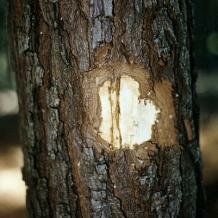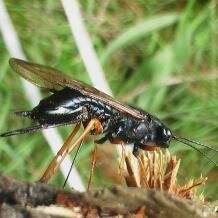Topic: Agriculture in wood wasps
The most famous hymenopteran farmers are, without doubt, the attine ants. Rightly so, but they are not the only ones...
Although insect agriculture has very much focussed, and rightly so, on the remarkable example of the attine ants, not only has it evolved independently in other ants but also in another group of Hymenoptera, the wood wasps. Wood wasp is a colloquial name used for several families of sawflies (Symphyta), a suborder characterised by a broad connection between thorax and abdomen (as opposed to the ‘wasp waist’ typical of other hymenopterans), caterpillar-like larvae and a saw-like ovipositor. All wood wasps have in common that their larvae are found in wood, but those in the families Siricidae (also known as horntails owing to a spine located on the last abdominal segment) and Xiphydriidae are a bit more special. They form an intimate association with symbiotic fungi and show a number of striking convergences with the fungus-farming ambrosia beetles and gall midges.
Siricidae
The larvae of some siricids (e.g. Sirex, Tremex and Urocerus) bore into wood, forming galleries that are colonised by wood-decaying basidiomycetes (e.g. Cerrena, Stereum and Amylostereum).  These fungi are introduced by the female upon oviposition and transported in specialised intersegmental pockets (mycangia) at the base of the ovipositor. The mycangia contain a slime-like substance and fragments of fungal mycelium, which newly ecdysed females collect before emerging from the gallery. The fungus is crucial for larval development. The larvae mainly feed on the wood, but rely on ingested fungal enzymes to break down cellulose (in some species, the fungus might also be directly used for nutrition). Experiments have shown that the gut fluid of Sirex cyaneus larvae is not active against cellulose or xylan, so the digestion of these polysaccharides is carried out entirely by enzymes produced by the fungal symbiont (Amylostereum chailletii). Like ambrosia beetles, wood wasps probably encounter toxic secondary plant metabolites, such as terpene resins and polyphenols. It is still unclear whether detoxification occurs by the insect and/or by the fungus. The fungi strongly rely on the insects for dispersal and the inoculation into trees.
These fungi are introduced by the female upon oviposition and transported in specialised intersegmental pockets (mycangia) at the base of the ovipositor. The mycangia contain a slime-like substance and fragments of fungal mycelium, which newly ecdysed females collect before emerging from the gallery. The fungus is crucial for larval development. The larvae mainly feed on the wood, but rely on ingested fungal enzymes to break down cellulose (in some species, the fungus might also be directly used for nutrition). Experiments have shown that the gut fluid of Sirex cyaneus larvae is not active against cellulose or xylan, so the digestion of these polysaccharides is carried out entirely by enzymes produced by the fungal symbiont (Amylostereum chailletii). Like ambrosia beetles, wood wasps probably encounter toxic secondary plant metabolites, such as terpene resins and polyphenols. It is still unclear whether detoxification occurs by the insect and/or by the fungus. The fungi strongly rely on the insects for dispersal and the inoculation into trees.
Thus, the association between siricid wood wasps and fungi is a stable symbiosis, where the partners are interdependent and show various adaptations to sustaining this mutualism.  However, it is still not fully understood how specific the fungus-wasp associations are in general and whether a particular wasp species is always associated with a particular species of fungus. At least, there seems to be a dominant species.
However, it is still not fully understood how specific the fungus-wasp associations are in general and whether a particular wasp species is always associated with a particular species of fungus. At least, there seems to be a dominant species.
Xiphydriidae
Wood wasps in the family Xiphydriidae, which is largely confined to the northern hemisphere, are less well studied. Xiphydria females live in a symbiosis with xylariaceous ascomycetes (e.g. Daldinia decipiens and Entonaema cinnabarina), the spores of which they carry in mycangia at the proximal end of the ovipositor. The unusually structured mycangia of the Japanese species Xiphydria ogasawarai seem to contain spores of a single fungal species, embedded in a mucus that is produced by glandular organs in the female’s body cavity and homologous to the mucus found in siricids.
Economic impact

 Although wood wasps usually target weakened trees, they can still cause serious economic damage. For example, the accidental introduction of Sirex noctilio and its fungal symbiont Amylostereum areolatum into North America (probably via shipped wooden articles such as packing materials) has led to huge losses in pine plantations. Wasp females deposit the fungus along with toxic mucus upon oviposition, which creates a suitable environment for the larvae to develop but proves fatal for the tree. It has been estimated that, if no action is undertaken to control this pest complex, losses amounting to almost 2 billion US $ will occur within the next 50 years or so. The insect and its fungus also pose a threat to plantings of North American pines that were introduced to the southern hemisphere for timber and pulp production, resulting in tree mortality of up to 70%.
Although wood wasps usually target weakened trees, they can still cause serious economic damage. For example, the accidental introduction of Sirex noctilio and its fungal symbiont Amylostereum areolatum into North America (probably via shipped wooden articles such as packing materials) has led to huge losses in pine plantations. Wasp females deposit the fungus along with toxic mucus upon oviposition, which creates a suitable environment for the larvae to develop but proves fatal for the tree. It has been estimated that, if no action is undertaken to control this pest complex, losses amounting to almost 2 billion US $ will occur within the next 50 years or so. The insect and its fungus also pose a threat to plantings of North American pines that were introduced to the southern hemisphere for timber and pulp production, resulting in tree mortality of up to 70%.
Cite this web page
Map of Life - "Agriculture in wood wasps"
https://mapoflife.org/topics/topic_472_agriculture-in-wood-wasps/
November 29, 2020

